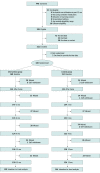Long-term Effectiveness of a Peer-Led Asthma Self-management Program on Asthma Outcomes in Adolescents Living in Urban Areas: A Randomized Clinical Trial
- PMID: 34874404
- PMCID: PMC8652603
- DOI: 10.1001/jamanetworkopen.2021.37492
Long-term Effectiveness of a Peer-Led Asthma Self-management Program on Asthma Outcomes in Adolescents Living in Urban Areas: A Randomized Clinical Trial
Abstract
Importance: Long-term effectiveness of a peer-led asthma self-management program in improving asthma outcomes in adolescents living in urban areas has not been established.
Objective: To determine the long-term effects of a peer-led program on asthma control, quality of life, and asthma management among predominantly racial and ethnic minority adolescents living in urban areas.
Design, setting, and participants: A parallel-group, randomized clinical trial was conducted in 2015 to 2019 in 3 metropolitan cities in the US: Buffalo, New York; Baltimore, Maryland; and Memphis, Tennessee. Adolescents aged 12 to 17 years old with persistent asthma were recruited mainly through clinical practices and schools. Participants were followed-up for 15 months after the intervention. Double-blinding was achieved for baseline. Data analysis was performed from June 2019 to June 2020.
Interventions: The intervention group received a peer-led asthma self-management program; the control group received the identical program led by adult health care professionals. Peer leaders made follow-up contacts every other month for 12 months.
Main outcomes and measures: The primary outcome was quality of life measured by the Pediatric Asthma Quality of Life Questionnaire, which consists of 3 subscales that measure symptoms (10 items), activity limitations (5 items), and emotional functioning (8 items) in the past 2 weeks. Each item was measured on a 7-point scale, with higher mean scores indicating better quality of life. Secondary measures included the Asthma Control Questionnaire and an asthma self-management index capturing steps to prevent and manage symptoms, self-efficacy, and lung function.
Results: Of 395 eligible adolescents, 35 refused, 38 did not show or were lost to contact, and 2 withdrew before randomization; 320 adolescents participated (mean [SD] age, 14.3 [1.71] years), including 168 boys (52.5%), 251 Black or African American adolescents (78.4%), and 232 adolescents (72.5%) with public health insurance. Of 320 enrolled, 303 were included in the longitudinal analysis. Response rates were 80% or higher at all time points. The peer-led group had greater improvement in outcomes than the adult-led group, with adjusted mean differences (AMDs) between baseline and 15 months of 0.75 vs 0.37 for quality of life (between-group AMD, 0.38; 95% CI, 0.07 to 0.63) and -0.59 vs -0.31 for asthma control (between-group AMD, -0.28; 95% CI, -0.51 to -0.01). Outcomes were not affected by bimonthly contact doses.
Conclusions and relevance: In this randomized clinical trial, a peer-led asthma self-management education was more effective than an adult-led program in improving asthma outcomes, with the improvements sustained for up to 15 months. These findings suggest that a peer-led asthma self-management program should be considered in addressing the disproportionate asthma burden in racial and ethnic minority adolescents living in urban communities.
Trial registration: ClinicalTrials.gov Identifier: NCT02293499.
Conflict of interest statement
Figures



Similar articles
-
Effects of a peer-led asthma self-management program for adolescents.Arch Pediatr Adolesc Med. 2011 Jun;165(6):513-9. doi: 10.1001/archpediatrics.2011.79. Arch Pediatr Adolesc Med. 2011. PMID: 21646583 Free PMC article. Clinical Trial.
-
Evaluation of a Peer-led Asthma Self-management Group Intervention for Urban Adolescents.J Pediatr Nurs. 2019 Mar-Apr;45:1-6. doi: 10.1016/j.pedn.2018.12.011. Epub 2018 Dec 19. J Pediatr Nurs. 2019. PMID: 30594886 Free PMC article.
-
The effectiveness of school-based family asthma educational programs on the quality of life and number of asthma exacerbations of children aged five to 18 years diagnosed with asthma: a systematic review protocol.JBI Database System Rev Implement Rep. 2015 Oct;13(10):69-81. doi: 10.11124/jbisrir-2015-2335. JBI Database System Rev Implement Rep. 2015. PMID: 26571284
-
School-based self-management interventions for asthma in children and adolescents: a mixed methods systematic review.Cochrane Database Syst Rev. 2019 Jan 28;1(1):CD011651. doi: 10.1002/14651858.CD011651.pub2. Cochrane Database Syst Rev. 2019. PMID: 30687940 Free PMC article.
-
Behavioural modification interventions for medically unexplained symptoms in primary care: systematic reviews and economic evaluation.Health Technol Assess. 2020 Sep;24(46):1-490. doi: 10.3310/hta24460. Health Technol Assess. 2020. PMID: 32975190 Free PMC article.
Cited by
-
Socioeconomic determinants of asthma health.Curr Opin Pediatr. 2023 Jun 1;35(3):337-343. doi: 10.1097/MOP.0000000000001235. Epub 2023 Mar 2. Curr Opin Pediatr. 2023. PMID: 36861771 Free PMC article. Review.
-
Assessing asthma self-management education among US children with current asthma, Asthma Call-back Survey (ACBS) 2015-2017.J Asthma. 2023 Oct;60(10):1918-1925. doi: 10.1080/02770903.2023.2200842. Epub 2023 Apr 20. J Asthma. 2023. PMID: 37026680 Free PMC article.
-
Adherence and Self-management Interventions among Systemically Marginalized and Underserved Youth with Asthma.Clin Pract Pediatr Psychol. 2022 Dec;10(4):394-408. doi: 10.1037/cpp0000462. Clin Pract Pediatr Psychol. 2022. PMID: 37275278 Free PMC article.
-
Implementation of Coach McLungsSM into primary care using a cluster randomized stepped wedge trial design.BMC Med Inform Decis Mak. 2022 Nov 4;22(1):285. doi: 10.1186/s12911-022-02030-1. BMC Med Inform Decis Mak. 2022. PMID: 36333727 Free PMC article. Clinical Trial.
References
-
- Center for Disease Control and Prevention . Most recent national asthma data. Updated March 30, 2021. Accessed May 5, 2021. https://www.cdc.gov/asthma/most_recent_national_asthma_data.htm
-
- Akinbami LJ, Moorman JE, Liu X. Asthma prevalence, health care use, and mortality: United States, 2005-2009. Natl Health Stat Report. 2011;12(32):1-14. - PubMed

